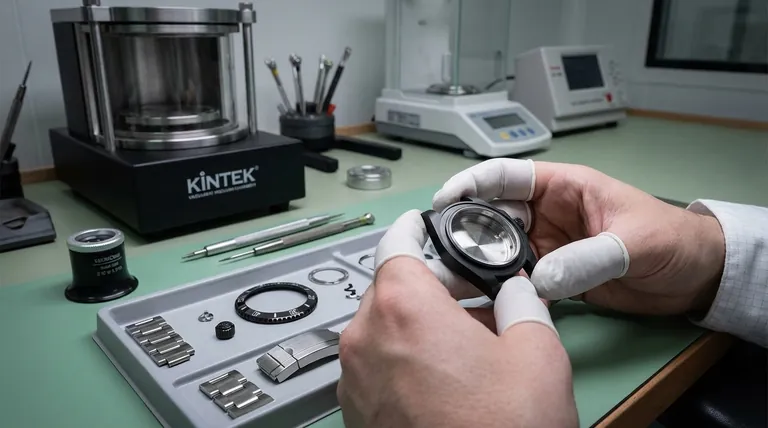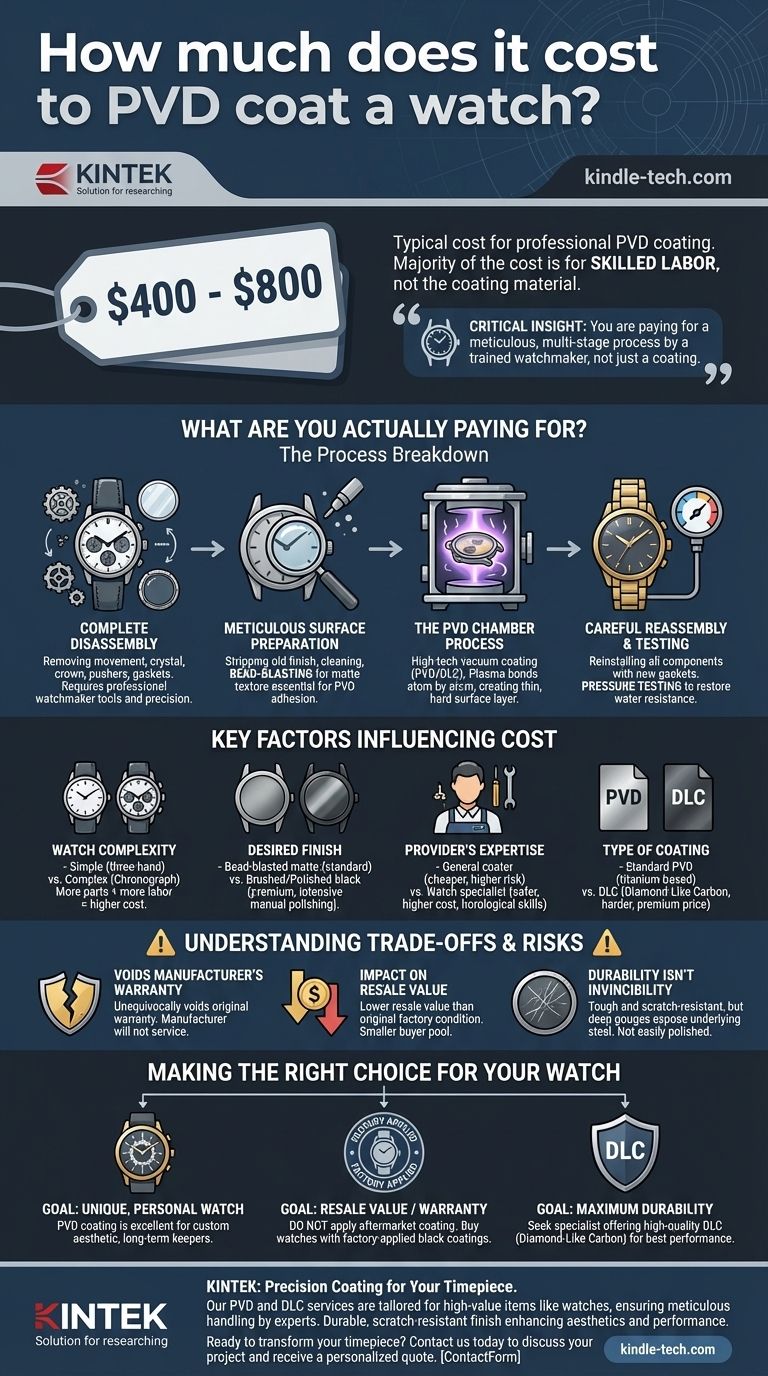To put it directly, getting a watch professionally PVD coated typically costs between $400 and $800. The final price depends heavily on the complexity of the watch and the expertise of the service provider, as the majority of the cost is for skilled labor, not the coating material itself.
The critical insight is that you are not simply paying for a coating. You are paying for a meticulous, multi-stage process that involves the complete disassembly, preparation, and reassembly of your watch by a trained watchmaker.

What Are You Actually Paying For? The Process Breakdown
The price becomes clear when you understand that coating a watch is a delicate and labor-intensive procedure. It's far more complex than coating a simple piece of metal.
Stage 1: Complete Disassembly
Before any coating can happen, the watch must be taken apart piece by piece. This includes removing the movement, crystal, crown, pushers, and every single gasket.
This task requires the precision and tools of a professional watchmaker to avoid damaging any of the sensitive components.
Stage 2: Meticulous Surface Preparation
This is the most crucial step for a durable and flawless finish. The watch case, bracelet, and crown are stripped of any old finish and meticulously cleaned.
The parts are then typically bead-blasted to create a uniform, matte texture. This micro-texture is essential for the PVD coating to adhere permanently to the steel surface.
Stage 3: The PVD Chamber Process
PVD (Physical Vapor Deposition) is a high-tech vacuum coating process. The prepared watch parts are placed in a vacuum chamber where a solid coating material (like titanium or carbon) is vaporized into a plasma.
This plasma then bonds to the watch parts atom by atom, creating a thin, hard, and durable surface layer. The most common and durable type for watches is DLC (Diamond-Like Carbon).
Stage 4: Careful Reassembly and Testing
Once the coating is complete, the watchmaker must carefully reassemble the entire watch. This involves reinstalling the crystal, movement, and all components with new gaskets to ensure functionality.
Finally, the watch undergoes pressure testing to guarantee its original water resistance rating has been restored.
Key Factors That Influence the Final Cost
Not all PVD coating jobs are priced the same. Several factors can significantly alter the final quote you receive.
The Complexity of the Watch
A simple three-hand watch with no complications is far easier to disassemble and reassemble than a chronograph. More complex watches have more parts, which means more labor and a higher cost.
The Desired Finish
The standard bead-blasted matte finish is the most common and cost-effective. If you want a brushed or polished black finish, the price will increase substantially due to the intensive manual polishing required before the parts enter the PVD chamber.
The Service Provider's Expertise
Choosing a company that specializes in watch modification is critical. While a general industrial coater might be cheaper, they lack the horological skills to safely disassemble, reassemble, and test a complex timepiece. You are paying for their watchmaking expertise.
The Type of Coating
While often used interchangeably, PVD is the process and DLC is a specific type of coating. DLC (Diamond-Like Carbon) is harder and more scratch-resistant than standard titanium-based PVD coatings, and it often comes at a premium price.
Understanding the Trade-offs and Risks
Modifying your watch is a significant decision with permanent consequences that you must consider.
Voiding the Manufacturer's Warranty
Applying an aftermarket coating is a major modification that will unequivocally void your watch's original warranty. The manufacturer will no longer service the timepiece under its guarantee.
Impact on Resale Value
Customization is deeply personal. While you may love the new look, a modified watch will almost always have a lower resale value than one in its original factory condition. The pool of potential buyers shrinks dramatically.
Durability Isn't Invincibility
DLC and PVD coatings are extremely tough and scratch-resistant, but they are not indestructible. A very deep gouge can still penetrate the coating and expose the silver-colored stainless steel underneath. Unlike a scratch on bare steel, this cannot be easily polished out.
Making the Right Choice for Your Watch
Deciding whether to PVD coat your watch depends entirely on your goals for the timepiece.
- If your primary focus is creating a unique, personal watch: PVD coating is an excellent way to achieve a custom aesthetic for a watch you love and plan to keep long-term.
- If your primary focus is preserving resale value or warranty: Absolutely do not apply an aftermarket coating. Instead, look for watches sold directly from manufacturers with factory-applied black coatings.
- If your primary focus is maximum durability and scratch resistance: Seek out a specialist that explicitly offers a high-quality DLC (Diamond-Like Carbon) coating, as it provides the best performance.
Ultimately, understanding the full process empowers you to decide if this permanent modification is the right investment for your timepiece.
Summary Table:
| Factor | Impact on Cost |
|---|---|
| Watch Complexity | Simple watch (lower cost) vs. Chronograph (higher cost) |
| Desired Finish | Bead-blasted matte (standard) vs. Brushed/Polished (premium) |
| Coating Type | Standard PVD (lower cost) vs. DLC (Diamond-Like Carbon) (premium) |
| Service Provider | General coater (riskier) vs. Watch specialist (safer, higher cost) |
Ready to transform your timepiece with a professional, durable coating?
At KINTEK, we understand that precision is paramount. Our PVD and DLC coating services are tailored for high-value items like watches, ensuring meticulous handling by experts who respect the integrity of your equipment. We provide a durable, scratch-resistant finish that enhances both aesthetics and performance.
Contact us today to discuss your project and receive a personalized quote. Let KINTEK's expertise in precision coating deliver the exceptional results your watch deserves.
Visual Guide

Related Products
- Inclined Rotary Plasma Enhanced Chemical Vapor Deposition PECVD Equipment Tube Furnace Machine
- RF PECVD System Radio Frequency Plasma-Enhanced Chemical Vapor Deposition RF PECVD
- Vacuum Hot Press Furnace Machine for Lamination and Heating
- Chemical Vapor Deposition CVD Equipment System Chamber Slide PECVD Tube Furnace with Liquid Gasifier PECVD Machine
- Microwave Plasma Chemical Vapor Deposition MPCVD Machine System Reactor for Lab and Diamond Growth
People Also Ask
- What is plasma enhanced chemical vapour deposition process? Unlock Low-Temperature, High-Quality Thin Films
- What is the difference between CVD and PECVD? Choose the Right Thin-Film Deposition Method
- What is plasma in CVD process? Lowering Deposition Temperatures for Heat-Sensitive Materials
- What is PECVD silicon deposition? Achieve Low-Temperature, High-Quality Thin Films
- How does plasma enhanced CVD work? Achieve Low-Temperature, High-Quality Thin Film Deposition



















